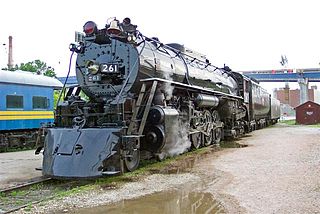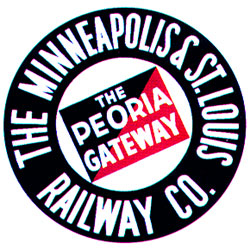Related Research Articles

The Central Pacific Railroad (CPRR) was a rail company chartered by U.S. Congress in 1862 to build a railroad eastwards from Sacramento, California, to complete the western part of the "First transcontinental railroad" in North America. Incorporated in 1861, CPRR ceased operation in 1959 when assets were formally merged into the Southern Pacific Railroad.

Calico is a ghost town and former mining town in San Bernardino County, California, United States. Located in the Calico Mountains of the Mojave Desert region of Southern California, it was founded in 1881 as a silver mining town, and was later converted into a county park named Calico Ghost Town. Located off Interstate 15, it lies 3 miles (4.8 km) from Barstow and 3 miles from Yermo. Giant letters spelling CALICO are visible, from the highway, on the Calico Peaks behind it. Walter Knott purchased Calico in the 1950s, and rebuilt all but the five remaining original buildings to look as they did in the 1880s. Calico received California Historical Landmark #782, and in 2005 was proclaimed by then-Governor Arnold Schwarzenegger to be California's Silver Rush Ghost Town.

Milwaukee Road 261 is a class "S3" 4-8-4 "Northern" type steam locomotive built by the American Locomotive Company (ALCO) in Schenectady, New York in July 1944 for the Milwaukee Road.

The Norfolk and Western Railway, commonly called the N&W, was a US class I railroad, formed by more than 200 railroad mergers between 1838 and 1982. It was headquartered in Roanoke, Virginia, for most of its existence. Its motto was "Precision Transportation"; it had a variety of nicknames, including "King Coal" and "British Railway of America". In 1986, N&W merged with Southern Railway to form today's Norfolk Southern Railway.

The Chicago and North Western was a Class I railroad in the Midwestern United States. It was also known as the "North Western". The railroad operated more than 5,000 miles (8,000 km) of track at the turn of the 20th century, and over 12,000 miles (19,000 km) of track in seven states before retrenchment in the late 1970s. Until 1972, when the employees purchased the company, it was named the Chicago and North Western Railway.

Yermo is an unincorporated community in the Mojave Desert in San Bernardino County, California. It is 13 miles (21 km) east of Barstow on Interstate 15, just south of the Calico Mountains. Its population was an estimated 1,750 in 2009.

Daggett is an unincorporated community located in San Bernardino County, California in the United States. The town is located on Interstate 40 ten miles (16 km) east of Barstow. The town has a population of about 200. The ZIP code is 92327 and the community is inside area code 760.
Garnerville, previously known as Calicotown, is a hamlet in the town of Haverstraw, Rockland County, New York, United States, located north of New York City; east of Mount Ivy; south of Stony Point and west of West Haverstraw. Most of the hamlet is within the West Haverstraw village, while a small portion of Garnerville defaults to the town of Haverstraw.

The Minneapolis and St. Louis Railway (M&StL) was an American Class I railroad that built and operated lines radiating south and west from Minneapolis, Minnesota for 90 years from 1870 to 1960. The railway never reached St. Louis but its North Star Limited passenger train ran to that city via the Wabash Railroad.
The Boyne City Railroad was a railway based at Boyne City, Michigan, U.S., during 1893–1978.

The Clinton Railroad Bridge, also called the Chicago and Northwestern Railway Bridge or more simply the Clinton Bridge, is a bridge that carries double tracked rail lines across the Mississippi River between Clinton, Iowa, and Fulton (Albany), Illinois. The bridge is a truss bridge with a swing span crossing the main river channel and is adjacent to the Gateway Bridge. The original bridge was constructed in 1858, and the first train crossed the bridge on January 19, 1860. The bridge was the second railroad crossing over the Mississippi River. In 1870, the bridge was declared a post route, therefore stopping the occupation of steamboats and approval of railroads. From 1859 to 1908, the mileage in operation increased from 28,789 to 229,230, prompting the Chicago and North Western Railway to replace the bridge with a new structure in 1900.
The Chesapeake Bay Bridge and Tunnel District is a political subdivision of the Commonwealth of Virginia. It is overseen by the Chesapeake Bay Bridge and Tunnel Commission, and operates the Chesapeake Bay Bridge-Tunnel between the Hampton Roads and Eastern Shore regions of the state. The District comprises six cities, Virginia Beach, Norfolk, Portsmouth, Chesapeake, Hampton, Newport News, and the two Eastern Shore counties of Northampton and Accomack.

Donna's Ranch is a legal, licensed brothel located in Nevada, United States. Donna's Ranch is situated in Wells, in Elko County, on 8th Street. The ranch traces its history back to 1867 and is owned by Geoff Arnold. The boxer Jack Dempsey was a previous owner.

David Joyce was an American "lumber baron" and industrialist. His fortune was eventually inherited by Beatrice Joyce Kean who used it to establish the Joyce Foundation in 1948.

Holder is an unincorporated community in Old Town Township, McLean County, Illinois.
Davenport, Iowa, was part of the Louisiana Purchase. In 1814, during the War of 1812 the British military, along with the Saux and Fox Indian tribes fought against the Americans near Davenport. In August, Major Zachary Taylor, later President, fought a battle east of what is now Credit Island Park, in Davenport. An outpost was set up at Fort Armstrong and George Davenport and Antoine LeClaire were stationed there.
Sully v. Drennan, 113 U.S. 287 (1885), was an appeal from an order of the Circuit Court for the Southern District of Iowa in the United States remanding to the state court a case which had been removed from the state into the circuit court.
The Muscatine and Iowa City Railway was a short-lived railroad that leased several lines in southeastern Iowa in 1916 from the Chicago, Rock Island and Pacific Railway. Those lines had been built in the 1870s and 1880s by predecessors of the Rock Island, and were mostly abandoned in the 1970s.

The Grenada Railroad is a 228-mile long (290 km) shortline railroad that runs from Southaven, Mississippi to Canton, Mississippi, along the former Illinois Central Railroad trackage. The GRYR interchanges at Canton, Mississippi, with the Canadian National, and at Memphis, Tennessee with CN, Norfolk Southern, Union Pacific, Canadian Pacific Kansas City, BNSF and CSX. The main commodities the Class III railroad hauls include chemicals, flour, lumber, paper, plastics, and petroleum. The Grenada Railroad is operated by Gulf & Atlantic Railways LLC.

The Waterloo Mining Railroad, also known as the Calico Railroad or Daggett-Calico Railroad, was a 3 ft narrow gauge railroad built to carry silver ore from the mines in the Calico Mountains north of Calico to the mills located at Elephant Mountain near Daggett, California, from 1888 to 1903.
References
- Dictionary of American History by James Truslow Adams, New York: Charles Scribner's Sons, 1940